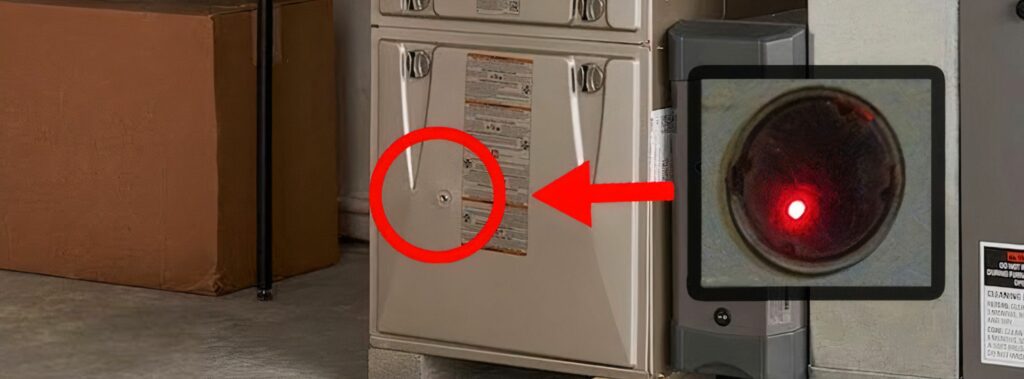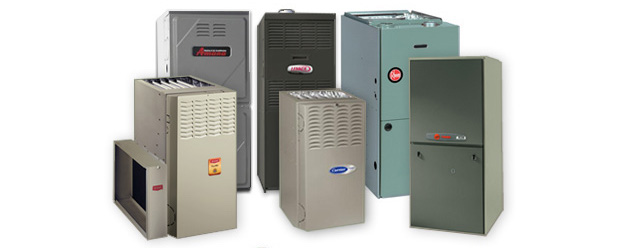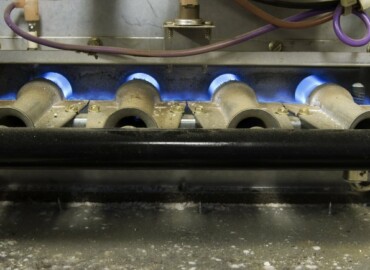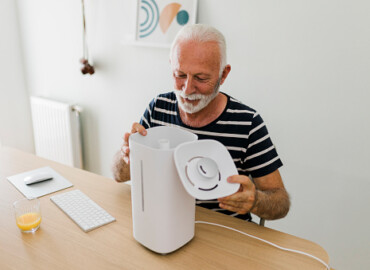Furnace Blinking Red Light: What Does It Mean?
A furnace blinking red light serves as a diagnostic tool, with each blink or series of blinks representing a specific error code. These codes help you identify the issue with your furnace, enabling you to take the appropriate action to resolve the problem.
To accurately interpret the error codes, it is essential to consult your furnace’s owner’s manual or seek assistance from a professional HVAC technician. However, some common issues are often indicated by a blinking red light on various furnace brands.
Why Your Furnace Is Blinking a Red Light?
Reason 1: No Signal from the Thermostat
A blinking red light may indicate that your thermostat is not sending a signal to the furnace. This could be due to faulty wiring within your walls or a loose wire connection.
Solution: Check all connections and ensure they are secure. If the wiring appears to be in good condition, consider replacing your thermostat.
Reason 2: No Power
If your furnace is not receiving power, the red light may not be on at all. This could be due to a tripped circuit breaker or a more significant electrical issue.
Solution: Check your circuit breaker box to ensure the furnace switch is on. If the breaker is tripped, reset it. If the issue persists, consult a professional HVAC technician.
Reason 3: Flame Failure
A furnace blinking red light may indicate a failure to ignite a steady, hot flame. This could be due to clogged filters, a dirty burner chamber or tank, broken burners, or excessive pressure in the combustion chambers.
Solution: Clean or replace filters as needed, remove debris from the burner chamber and tank, inspect for broken parts, and address any pressure issues.
Reason 4: Igniter Failure
If your furnace’s igniter is not functioning properly, the red light may blink to indicate an issue. The igniter is responsible for sparking the pilot light, which ignites the flame.
Solution: Replace or repair the igniter as needed.
Reason 5: Pressure Switch Problem
A pressure switch issue can cause a furnace to blink red light. The pressure switch monitors the system’s ventilation of harmful gases. A clogged condensate drain or vent blockage could lead to a pressure switch malfunction.
Solution: Inspect and clear any blockages in the condensate drain or vent. If necessary, replace the pressure switch.
Reason 6: Gas Valve Issue
A faulty gas valve can cause a furnace to blink red light, as insufficient gas pressure may prevent the unit from igniting properly. A damaged gas valve may also leak gas and lower the pressure.
Solution: Adjust the gas pressure or replace the gas valve as needed.
Reason 7: High Limit Switch & Roll-Out Switch
A blinking red light may also indicate issues with the high limit switch or roll-out switch. The high-limit switch monitors the temperature of the heat exchanger, while roll-out switches monitor for heat in areas where it should not be present.
Solution: Inspect and clean or replace the switches as needed.
Reason 8: Circuit Board Failure
A circuit board failure can cause a furnace to blink red light, as damaged components or short circuits may prevent the unit from operating correctly.
Solution: Consult a professional HVAC technician to diagnose and repair or replace the circuit board.
Reason 9: Voltage Issue
A voltage issue, such as a reversed polarity or insufficient power, may cause a furnace to blink red light.
Solution: Check your circuit breakers and ensure they are supplying adequate power to the furnace. Consult an HVAC technician for assistance with any wiring or voltage issues.
Gas Furnace Red Light Error Codes by Brand
Each furnace brand has its specific error codes, which can help you identify the problem with your unit. While the general principles of troubleshooting a furnace blinking red light remain the same, it is essential to understand the error codes specific to your furnace brand for accurate diagnosis.
1. Trane Furnace Blinking Red Light Error Codes
Trane furnaces use a series of blinking red lights to indicate specific issues. The number of blinks corresponds to a particular error code. Some common Trane furnace error codes include:
- Slow flashing: Normal operation, no heat demand
- Fast flashing: Normal operation, heat demand present
- Continuous on: The control panel issue, requires replacement
- Continuous off: Check the power supply to the furnace
- 2 Flashes: External lockout, furnace resets after 1 hour
- 3 Flashes: Pressure switch issue, inspect drain tubes
- 4 Flashes: High limit switch tripped, replace air filters or check for blockages
2. Goodman Furnace Blinking Red Light Error Codes
Goodman Furnaces also uses a series of blinking red lights to convey error codes. Some common Goodman furnace error codes include:
- Steady on: Control failure, replace control board
- 1 Flash: System locked out, wait for the furnace to reset
- 2 Flashes: Pressure switch is stuck, fix or replace the switch
- 3 Flashes: Pressure switch stuck open, check for blockages
- 4 Flashes: High limit switch open, clean or replace filters
3. York Furnace Blinking Red Light Error Codes
York furnaces use a simple system of red light flashes to indicate issues. Some common York furnace error codes include:
- 1 Flash: Gas valve issue, leaky or slow closing valve
- 2 Flashes: Pressure switch stuck closed, clean or replace switch
- 3 Flashes: Pressure switch stuck open, clean or replace the switch
- 4 Flashes: High limit switch open, check for clogged air filter or restricted airflow
4. Carrier Furnace Blinking Red Light
Carrier furnaces use a combination of short and long flashes to represent two-digit error codes. Some common Carrier furnace error codes include:
- 1 Short, 1 Long: Stored codes erased due to power interruption
- 1 Short, 2 Long: Blower on after power-up, normal operation
- 1 Short, 3 Long: Roll-out switch lockout, reset switch, or replace fuse link
- 2 Short, 1 Long: Gas heating lockout, check gas valve or wiring
How To Prevent Getting a Blinking Red Light From Furnace
To minimize the risk of encountering a furnace blinking red light, it is essential to perform regular preventative maintenance on your heating system. This includes:
- Changing air filters every 30-90 days
- Cleaning and inspecting the burner chamber and tank
- Checking for damaged or broken parts
- Inspecting and clearing any blockages in the condensate drain or vent
- Scheduling annual professional maintenance and inspection
By taking these proactive steps, you can help ensure the longevity and efficiency of your furnace, reducing the likelihood of encountering a red light.
Conclusion
A furnace blinking red light serves as a warning signal that something is wrong with your heating system. By understanding the common causes of this issue and how to address them, you can take appropriate action to resolve the problem and maintain the comfort of your home.
However, if you are unsure of how to address a furnace blinking light or if your attempts at troubleshooting have been unsuccessful, it is best to consult a professional HVAC technician.
If you are looking for furnace repair and service in Toronto, our team of authorized technicians can accurately diagnose the issue and provide the necessary repairs to ensure your furnace operates efficiently and safely.
By staying vigilant and performing regular preventative maintenance on your furnace, you can minimize the risk of encountering a furnace blinking light and keep your home comfortable throughout the heating season.
FAQ
What does a blinking red light mean?
A blinking red light on your furnace typically indicates an issue or error code. The specific meaning of the code can vary depending on your furnace model and manufacturer. Consult your furnace's manual or a professional technician to interpret the code and address the problem.
Why is my furnace blinking red light 4 times?
If your furnace is flashing a red light four times, it's likely displaying an error code specific to your furnace's manufacturer and model. Check the manual or contact a professional technician to diagnose and resolve the issue.
How do I reset my furnace?
To reset your furnace, you usually need to turn off the power supply to the unit, wait for a few minutes, and then turn it back on. However, it's crucial to follow your furnace's specific reset procedure as outlined in the user manual or contact a professional technician for guidance.
Why is my furnace light blinking red and green?
A red and green blinking light may represent a specific error code for your furnace. The meaning of this code can differ between furnace models and manufacturers. Refer to your furnace's manual or consult a professional technician to determine the issue and find a solution.
Why is my furnace flashing a red light 3 times?
A furnace flashing a red light three times typically indicates a specific fault or problem within the unit. To identify the issue, consult your furnace's manual or reach out to a qualified technician for troubleshooting and repair.
Why is my furnace light blinking 3 times carrier?
A Carrier furnace with a three-blinking-light pattern is signaling an error code specific to Carrier systems. To understand the issue and resolve it, reference the Carrier furnace manual or get in touch with a certified Carrier technician who can diagnose and fix the problem accurately.





